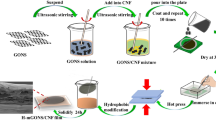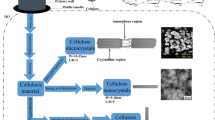Abstract
Nanofibrilated cellulose (NFC) films have potential to replace synthetic polymers as flexible films for packaging. However, NFC is hydrophilic and water acts as plasticizer decreasing the stiffness of the films and reducing its barrier effectiveness against water vapor and oxygen. Here we describe the surface modification of cellulose films with blocked diisocyanates through a dip** and heating process not requiring the previous drying of the materials. The reactions were conducted at 170 °C for a few minutes during which deblocking led to a new urethane bond formation with NFC surface hydroxyl groups, thus hydrophobizing the films. A remarkable enhancement in water repellent properties was confirmed by water contact angles higher than 110° and water vapor transmission rate (WVTR) of 40 g/m2 day, which is very low when compared to similar materials, representing a reduction of 74% with respect to the non- modified films.
Graphic abstract












modified by the dip** plus heating treatment with the blocked diisocyanate


Similar content being viewed by others
Availability of data and material
Data will be available on request.
References
Arbatan T, Zhang L, Fang X-Y, Shen W (2012) Cellulose nanofibers as binder for fabrication of superhydrophobic paper. Chem Eng J 210:74–79. https://doi.org/10.1016/j.cej.2012.08.074
Carvalho AJF, Curvelo AAS, Gandini A (2005) Surface chemical modification of thermoplastic starch: Reactions with isocyanates, epoxy functions and stearoyl chloride. Ind Crops Prod 21:331–336. https://doi.org/10.1016/j.indcrop.2004.04.027
Chen Y, Geng B, Ru J et al (2017) Comparative characteristics of TEMPO-oxidized cellulose nanofibers and resulting nanopapers from bamboo, softwood, and hardwood pulps. Cellulose 24:4831–4844. https://doi.org/10.1007/s10570-017-1478-4
Delebecq E, Pascault JP, Boutevin B, Ganachaud F (2013) On the versatility of urethane/urea bonds: Reversibility, blocked isocyanate, and non-isocyanate polyurethane. Chem Rev 113:80–118. https://doi.org/10.1021/cr300195n
Djafari Petroudy SR, Rahmani N, Rasooly Garmaroody E et al (2019) Comparative study of cellulose and lignocellulose nanopapers prepared from hard wood pulps: Morphological, structural and barrier properties. Int J Biol Macromol 135:512–520. https://doi.org/10.1016/j.ijbiomac.2019.05.212
Dufresne A (2017) Handbook of Nanocellulose and Cellulose Nanocomposites. Wiley-VCH Verlag GmbH & Co, KGaA, Weinheim, Germany
Dufresne A, Dupeyre D, Vignon MR (2000) Cellulose microfibrils from potato tuber cells: Processing and characterization of starch-cellulose microfibril composites. J Appl Polym Sci 76:2080–2092. https://doi.org/10.1002/(SICI)1097-4628(20000628)76:14%3c2080::AID-APP12%3e3.0.CO;2-U
Ferrer A, Pal L, Hubbe M (2017) Nanocellulose in packaging: Advances in barrier layer technologies. Ind Crops Prod 95:574–582. https://doi.org/10.1016/j.indcrop.2016.11.012
Ferrer A, Salas C, Rojas OJ (2015) Dewatering of MNFC containing microfibrils and microparticles from soybean hulls: mechanical and transport properties of hybrid films. Cellulose 22:3919–3928. https://doi.org/10.1007/s10570-015-0768-y
Garusinghe UM, Varanasi S, Raghuwanshi VS et al (2018) Nanocellulose-montmorillonite composites of low water vapour permeability. Colloids Surfaces A Physicochem Eng Asp 540:233–241. https://doi.org/10.1016/j.colsurfa.2018.01.010
Gironès J, Pimenta MTB, Vilaseca F et al (2007) Blocked isocyanates as coupling agents for cellulose-based composites. Carbohydr Polym 68:537–543. https://doi.org/10.1016/j.carbpol.2006.10.020
Gironès J, Pimenta MTB, Vilaseca F et al (2008) Blocked diisocyanates as reactive coupling agents: Application to pine fiber-polypropylene composites. Carbohydr Polym 74:106–113. https://doi.org/10.1016/j.carbpol.2008.01.026
Heinze T (2016) Cellulose Chemistry and Properties: Fibers, Nanocelluloses and Advanced Materials. In: Rojas OJ (ed) Advances in Polymer Science 271. Springer International Publishing, Cham, p 341
Hu Y, Acharya S, Abidi N (2019) Cellulose porosity improves its dissolution by facilitating solvent diffusion. Int J Biol Macromol 123:1289–1296. https://doi.org/10.1016/j.ijbiomac.2018.10.062
Hubbe MA, Gardner DJ, Shen W (2015) Wettability of cellulosics. BioResources 10:8657–8749
Klemm D, Cranston ED, Fischer D et al (2018) Nanocellulose as a natural source for groundbreaking applications in materials science: Today’s state. Mater Today 21:720–748. https://doi.org/10.1016/j.mattod.2018.02.001
Klemm D, Heublein B, Fink HP, Bohn A (2005) Cellulose: Fascinating biopolymer and sustainable raw material. Angew Chemie—Int Ed 44:3358–3393. https://doi.org/10.1002/anie.200460587
Li L, Zhou ZH, Yang B et al (2019a) Robust cellulose nanocomposite films based on covalently cross-linked network with effective resistance to water permeability. Carbohydr Polym 211:237–248. https://doi.org/10.1016/j.carbpol.2019.01.084
Li W, Wang S, Wang W et al (2019b) Facile preparation of reactive hydrophobic cellulose nanofibril film for reducing water vapor permeability (WVP) in packaging applications. Cellulose 26:3271–3284. https://doi.org/10.1007/s10570-019-02270-x
Liimatainen H, Ezekiel N, Sliz R et al (2013) High-strength nanocellulose-talc hybrid barrier films. ACS Appl Mater Interfaces 5:13412–13418. https://doi.org/10.1021/am4043273
Liu A, Walther A, Ikkala O et al (2011) Clay nanopaper with tough cellulose nanofiber matrix for fire retardancy and gas barrier functions. Biomacromol 12:633–641. https://doi.org/10.1021/bm101296z
Meyer-Stork LS, Höcker H, Berndt H (1992) Syntheses and reactions of urethanes of cellobiose and cellulose-containing uretdione groups. J Appl Polym Sci 44:1043–1049. https://doi.org/10.1002/app.1992.070440613
Operamolla A (2019) Recent advances on renewable and biodegradable cellulose nanopaper substrates for transparent light-harvesting devices: Interaction with humid environment. Int J Photoenergy. https://doi.org/10.1155/2019/3057929
Ouyang X, Huang W, Cabrera E et al (2015) Graphene-graphene oxide-graphene hybrid nanopapers with superior mechanical, gas barrier and electrical properties. AIP Adv. https://doi.org/10.1063/1.4906795
Paquet O, Krouit M, Bras J et al (2010) Surface modification of cellulose by PCL grafts. Acta Mater 58:792–801. https://doi.org/10.1016/j.actamat.2009.09.057
Quinney RF, Banks WB, Lawther JM (1995) The activation of wood fibre for thermoplastic coupling, the reaction of wood with a potential coupling agent. J Wood Chem Technol 15:529–544. https://doi.org/10.1080/02773819508009524
Rahmani Seraji H, Karimi M, Mahmoudi L (2017) In situ monitoring the change of mechanical response induced by the diffusion of saline water in glassy cellulose acetate. Desalination 420:191–207. https://doi.org/10.1016/j.desal.2017.07.013
Rodionova G, Lenes M, Eriksen Ø, Gregersen Ø (2011) Surface chemical modification of microfibrillated cellulose: Improvement of barrier properties for packaging applications. Cellulose 18(1):127–134
Rojo E, Peresin MS, Sampson WW et al (2015) Comprehensive elucidation of the effect of residual lignin on the physical, barrier, mechanical and surface properties of nanocellulose films. Green Chem 17:1853–1866. https://doi.org/10.1039/c4gc02398f
Rueda L, Fernández d’Arlas B, Zhou Q et al (2011) Isocyanate-rich cellulose nanocrystals and their selective insertion in elastomeric polyurethane. Compos Sci Technol 71:1953–1960. https://doi.org/10.1016/j.compscitech.2011.09.014
Sehaqui H, Zimmermann T, Tingaut P (2014) Hydrophobic cellulose nanopaper through a mild esterification procedure. Cellulose 21:367–382. https://doi.org/10.1007/s10570-013-0110-5
Sethi J, Farooq M, Österberg M et al (2018) Stereoselectively water resistant hybrid nanopapers prepared by cellulose nanofibers and water-based polyurethane. Carbohydr Polym 199:286–293. https://doi.org/10.1016/j.carbpol.2018.07.028
Sethi J, Visanko M, Österberg M, Sirviö JA (2019) A fast method to prepare mechanically strong and water resistant lignocellulosic nanopapers. Carbohydr Polym 203:148–156. https://doi.org/10.1016/j.carbpol.2018.09.037
Sharma S, Zhang X, Nair SS et al (2014) Thermally enhanced high performance cellulose nano fibril barrier membranes. RSC Adv 4:45136–45142. https://doi.org/10.1039/c4ra07469f
Solala I, Bordes R, Larsson A (2018) Water vapor mass transport across nanofibrillated cellulose films: effect of surface hydrophobization. Cellulose 25:347–356. https://doi.org/10.1007/s10570-017-1608-z
Spence KL, Venditti RA, Rojas OJ et al (2011) Water vapor barrier properties of coated and filled microfibrillated cellulose composite films. BioResources 6:4370–4388
Urbina L, Corcuera MÁ, Eceiza A, Retegi A (2019) Stiff all-bacterial cellulose nanopaper with enhanced mechanical and barrier properties. Mater Lett 246:67–70. https://doi.org/10.1016/j.matlet.2019.03.005
Wang J, Gardner DJ, Stark NM et al (2018) Moisture and Oxygen Barrier Properties of Cellulose Nanomaterial-Based Films. ACS Sustain Chem Eng 6:49–70. https://doi.org/10.1021/acssuschemeng.7b03523
Wicks Da, Wicks ZW (1999) Blocked isocyanates III: Part A. Mechanisms and chemistry. Prog Org Coatings 36:148–172. https://doi.org/10.1016/S0300-9440(99)00042-9
Willberg-keyriläinen P, Vartiainen J, Pelto J, Ropponen J (2017) Hydrophobization and smoothing of cellulose nanofibril films by cellulose ester coatings. Carbohydr Polym 170:160–165. https://doi.org/10.1016/j.carbpol.2017.04.082
**a J, Zhang Z, Liu W et al (2018) Highly transparent 100% cellulose nanofibril films with extremely high oxygen barriers in high relative humidity. Cellulose 25:4057–4066. https://doi.org/10.1007/s10570-018-1843-y
Yousefi H, Faezipour M, Hedjazi S et al (2013) Comparative study of paper and nanopaper properties prepared from bacterial cellulose nanofibers and fibers/ground cellulose nanofibers of canola straw. Ind Crops Prod 43:732–737. https://doi.org/10.1016/j.indcrop.2012.08.030
Zhang C, Zhang Y, Cha R et al (2019) Manufacture of Hydrophobic Nanocomposite Films with High Printability. ACS Sustain Chem Eng 7:15404–15412. https://doi.org/10.1021/acssuschemeng.9b02856
Zheng M, Tajvidi M, Tayeb AH, Stark NM (2019) Effects of bentonite on physical, mechanical and barrier properties of cellulose nanofibril hybrid films for packaging applications. Cellulose 26:5363–5379. https://doi.org/10.1007/s10570-019-02473-2
Acknowledgments
This study was financed in part by the Coordenação de Aperfeiçoamento de Pessoal de Nível Superior—Brasil (CAPES)—Finance Code 001. Also, authors acknowledge CNPq for the doctoral fellowship granted to G.S (CNPq proc. 140249/2017-6). AJFC acknowledge CNPq for research funding project # 03847/2019-0.
Funding
This work was supported by Coordenação de Aperfeiçoamento de Pessoal de Nível Superior—Brasil (CAPES) – Grant number: Finance Code 001 and CNPq for the doctoral fellowship grant number CNPq proc. 140249/2017–6 both to GS and financial support to AJFC from CNPq for research funding project Grant number 03847/2019–0.
Author information
Authors and Affiliations
Contributions
The manuscript was written through contributions of all authors. All authors have given approval to the final version of the manuscript.
Corresponding author
Ethics declarations
Conflict of interest
The authors declare no competing financial interest.
Additional information
Publisher's Note
Springer Nature remains neutral with regard to jurisdictional claims in published maps and institutional affiliations.
Electronic supplementary material
Below is the link to the electronic supplementary material.
Rights and permissions
About this article
Cite this article
de Souza, G., Belgacem, M.N., Gandini, A. et al. Low permeable hydrophobic nanofibrilated cellulose films modified by dip** and heating processing technique. Cellulose 28, 1617–1632 (2021). https://doi.org/10.1007/s10570-020-03619-3
Received:
Accepted:
Published:
Issue Date:
DOI: https://doi.org/10.1007/s10570-020-03619-3




